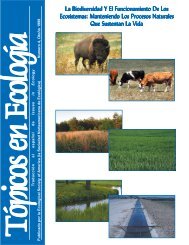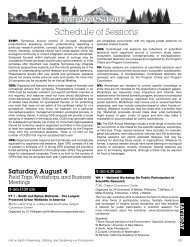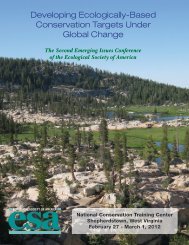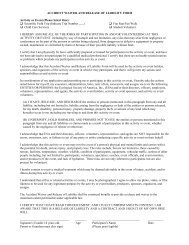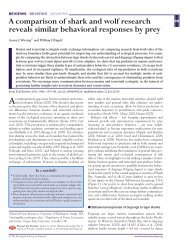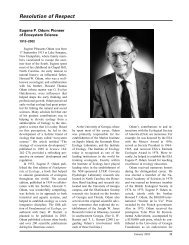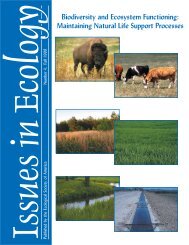Printed Program (PDF) - Ecological Society of America
Printed Program (PDF) - Ecological Society of America
Printed Program (PDF) - Ecological Society of America
Create successful ePaper yourself
Turn your PDF publications into a flip-book with our unique Google optimized e-Paper software.
4 pm-6 pm<br />
ESA <strong>Ecological</strong> Applications Editorial Board Meeting<br />
Ross Island, Doubletree Hotel<br />
4:30 pm-6:30 pm<br />
Royal <strong>Society</strong> Publishing Event (booth 204)<br />
Exhibit Hall DE, Oregon Convention Center<br />
OPS 2 - Building the National <strong>Ecological</strong> Observatory<br />
Network (NEON): Infrastructure, Field Sampling,<br />
Remote Sensing, Data Processing and Citizen Science<br />
During Year One <strong>of</strong> NEON Construction<br />
Exhibit Hall DE, Oregon Convention Center<br />
Organized by: WK Gram<br />
NEON is a continental-scale ecological observation platform for<br />
understanding and forecasting the impacts <strong>of</strong> climate change, land<br />
use change, and invasive species on ecology.<br />
OPS 2-1 Wee, B and J Taylor, National <strong>Ecological</strong> Observatory<br />
Network (NEON, Inc.). Multi-scalar strategy for connecting<br />
science to policy and resource management.<br />
OPS 2-2 Gram, WK, J Walton, S Henderson and DL Ward, National<br />
<strong>Ecological</strong> Observatory Network (NEON, Inc.). NEON<br />
education and outreach: Building capacity for using data,<br />
engaging communities and participating in citizen science.<br />
OPS 2-3 Fox, AM1, J Taylor1 and TJ Hoar2, (1)National <strong>Ecological</strong><br />
Observatory Network (NEON, Inc.), (2)National Center<br />
for Atmospheric Research. The impacts <strong>of</strong> uncertainty in<br />
observations on a data assimilation system for ecological<br />
forecasting.<br />
OPS 2-4 Beruk<strong>of</strong>f, S, National <strong>Ecological</strong> Observatory Network<br />
(NEON, Inc.). NEON data products: Enabling continentalscale<br />
ecological science.<br />
OPS 2-5 Springer, Y and RH Kao, National <strong>Ecological</strong> Observatory<br />
Network (NEON, Inc.). Sampling infectious diseases as part<br />
<strong>of</strong> the National <strong>Ecological</strong> Observatory Network.<br />
OPS 2-6 Thibault, KM, National <strong>Ecological</strong> Observatory Network<br />
(NEON, Inc.). Bird and mammal sampling strategies:<br />
NEON’s contribution to the continental-scale ecology <strong>of</strong><br />
vertebrates.<br />
OPS 2-7 Meier, CL, DT Barnett and K Krause, National <strong>Ecological</strong><br />
Observatory Network (NEON, Inc.). Developing a<br />
OPS 2-8<br />
methodology for consistent plant biomass and NPP<br />
estimates across NEON domains.<br />
Roehm, CL, M Slater and H Powell, National <strong>Ecological</strong><br />
Observatory Network (NEON, Inc.). Novel approach to<br />
define the morphology <strong>of</strong> shallow lakes.<br />
OPS 2-9 Parker, S, H Powell and C Roehm, National <strong>Ecological</strong><br />
Observatory Network (NEON, Inc.). NEON aquatic<br />
OPS 2-10<br />
macroinvertebrate sampling strategies over the continental<br />
scale.<br />
Krause, KS, N Leisso, TU Kampe, CL Meier, DT Barnett,<br />
ELS Hinckley and D Tazik, National <strong>Ecological</strong> Observatory<br />
Network (NEON, Inc.). Validation <strong>of</strong> NEON airborne remote<br />
sensing data.<br />
OPS 2-11 Kampe, T, K Krause, N Leisso and B Karpowicz, National<br />
<strong>Ecological</strong> Observatory Network (NEON, Inc.). NEON<br />
airborne remote sensing.<br />
OPS 2-12 Leisso, N, T Kampe, K Krause and B Karpowicz, National<br />
<strong>Ecological</strong> Observatory Network (NEON, Inc.). Early<br />
calibration results for the National <strong>Ecological</strong> Observatory<br />
Network’s airborne observation platform.<br />
OPS 2-13 Ayres, E1, HW Loescher1, P Duffy2 and H Luo1, (1)National<br />
<strong>Ecological</strong> Observatory Network (NEON, Inc.), (2)Neptune<br />
and Company, Inc. How many soil samples do I need and<br />
how far apart should I space them? A simple quantitative<br />
tool to guide soil sampling designs.<br />
OPS 2-14 Luo, H1, B Vaughn2, D Kath1, V Morris2 and HW Loescher1,<br />
(1)National <strong>Ecological</strong> Observatory Network (NEON, Inc.),<br />
(2)University <strong>of</strong> Colorado. Long-term strategies <strong>of</strong> the lab<br />
Life on Earth: Preserving, Utilizing, and Sustaining our Ecosystems<br />
4 pm-6 pm; 4:30 pm-6:30 pm<br />
and field calibration <strong>of</strong> a water isotopic instrument in the<br />
National <strong>Ecological</strong> Observatory Network.<br />
OPS 2-15 Loescher, HW1, PM Gr<strong>of</strong>fman2, DS Schimel1, DE Pataki3,<br />
N Grimm4, C Polsky5, H Powell1, T Kampe1 and D Tazik1,<br />
(1)National <strong>Ecological</strong> Observatory Network (NEON, Inc.),<br />
(2)Cary Institute <strong>of</strong> Ecosystem Studies, (3)University <strong>of</strong><br />
California, (4)Arizona State University, (5)Clark University.<br />
Key observations for long-term ecological understanding<br />
<strong>of</strong> urban environments.<br />
OPS 2-16 Powell, H1, R Utz1, J Fischer2, S Parker1 and C Roehm1,<br />
(1)National <strong>Ecological</strong> Observatory Network (NEON, Inc.),<br />
(2)Iowa State University. The NEON fish sampling design.<br />
PS 20 - Education: Community-Based Learning<br />
Exhibit Hall DE, Oregon Convention Center<br />
PS 20-17 Carey, TS1 and DW Katz2, (1)University <strong>of</strong> Michigan, Ann<br />
Arbor, (2)University <strong>of</strong> Michigan. Pollen and public health: A<br />
citizen science project.<br />
PS 20-18 Trimboli, SR1, C Messenger2 and RS Toomey III1, (1)<br />
Mammoth Cave International Center for Science<br />
and Learning, (2)Mammoth Cave National Park. The<br />
Geoscience-Teachers-in-the-Park internship: A model for<br />
engaging local teachers in hands-on research within the<br />
National Parks.<br />
PS 20-19 Beckstead, J, Gonzaga University. Creating authentic<br />
learning experiences that benefit undergraduate students<br />
and land management agencies.<br />
PS 20-20 Newman, S, S Henderson and D Ward, NEON, Inc..<br />
Partnerships for participation: Implementing continentalscale<br />
citizen science programs locally.<br />
PS 20-21 Jobse, JC1, R van der Duim2, A Pellis2, M Meijering3<br />
and W Helmer4, (1)Van Hall Larenstein University <strong>of</strong><br />
Applied Sciences, part <strong>of</strong> Wageningen UR, (2)Wageningen<br />
University, (3)Helicon Opleidingen, (4)Rewilding Europe &<br />
Ark Nature. Educating Europe’s future nature entrepreneurs.<br />
PS 20-22 Kidd, JB1, JR Seiler1, M Monroe2 and S Sriharan3, (1)<br />
Virginia Tech, (2)University <strong>of</strong> Florida, (3)Virginia State<br />
University. The PINEMAP Intern <strong>Program</strong>: Integrating<br />
undergraduates into forest resource and climate change<br />
research and education.<br />
PS 20-23 Cid, CR, Eastern Connecticut State University. Using the<br />
WonderWise model to engage minority students in ecology<br />
careers.<br />
PS 20-24 Maltz, MR, University <strong>of</strong> California, Irvine. Service learning<br />
in the Ecuadorian Amazon: Developing an inexpensive<br />
and easily interpretable plant bioassay for monitoring<br />
bioamendment mediated reductions in soil toxicity.<br />
PS 20-25 Wolf, JJ, University <strong>of</strong> Wisconsin - Parkside. Campus<br />
Partnership in a Citizen-Based Monitoring Network:<br />
Wisconsin Ephemeral Ponds Project.<br />
PS 20-26 Poole, AA, The MASTERS <strong>Program</strong> Early College Charter<br />
High School. Sustaining interest in sustainability: High<br />
school students use inquiry and service learning to connect<br />
education, community and the environment.<br />
PS 20-27 Sedgley, A1, P Hodum2, E Ward3, S Pearson4 and J<br />
Joyce1, (1)Seattle Audubon <strong>Society</strong>, (2)University <strong>of</strong><br />
Puget Sound, (3)Northwest Fisheries Science Center, (4)<br />
Washington Department <strong>of</strong> Fish and Wildlife. Puget Sound<br />
seabird survey: Science by citizens.<br />
PS 20-28 Barbosa, O1, J Díaz-Forestier1, W Marcelo1, K Godoy1,<br />
L Mansur2 and JL Celis-Diez1, (1)Institute <strong>of</strong> Ecology and<br />
Biodiversity, (2)Pontificia Universidad Católica de Chile.<br />
Outreach for sustainability practices in Chilean vineyards <strong>of</strong><br />
Mediterranean climate.<br />
PS 20-29 Schallert, KA, National Park Service. The Science<br />
Ambassadors: A case study <strong>of</strong> project based experiential<br />
learning as a tool to engage traditionally underserved<br />
communities in citizen science.<br />
PS 20-30 Macfall, J, M Strickland and C Leupold, Elon University.<br />
Student pr<strong>of</strong>essional development in applied ecology<br />
through civic engagement, project management and team<br />
building.<br />
PS 20-31 Ward, DL1, S Henderson2 and S Newman2, (1)National<br />
<strong>Ecological</strong> Observatory Network (NEON, Inc.), (2)NEON,<br />
Inc.. Exploring event and status based phenological<br />
TUESDAY<br />
91



